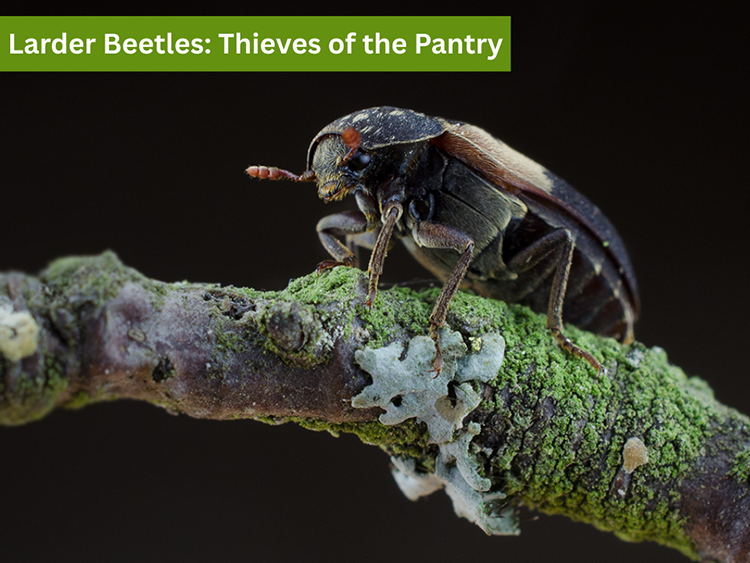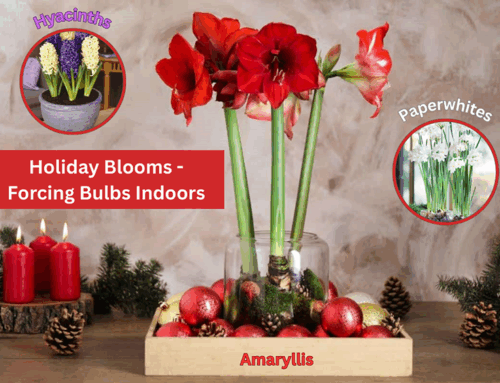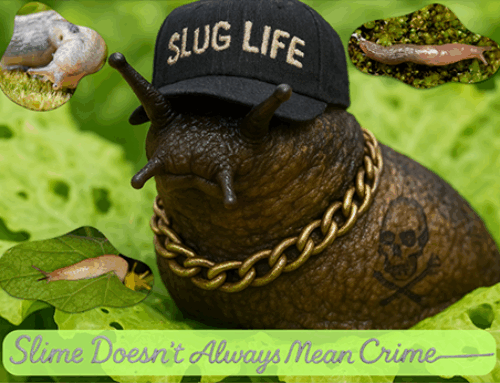Larder Beetles: Thieves of the Pantry
by Brett Kerley
About the Larder Beetle
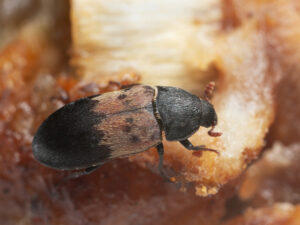 The Larder beetle (Dermestes lardarius) is a common pest in Edmonton kitchens and pantries.
The Larder beetle (Dermestes lardarius) is a common pest in Edmonton kitchens and pantries.
Adults are 7–9 mm long (0.7–0.9 cm; ~0.28–0.35 in), oval, and dark brown to black with a broad pale yellow band across the front half of the wings that holds six dark spots. The underside and legs are often reddish-brown.
Larvae are 10–15 mm when mature (1.0–1.5 cm; ~0.39–0.59 in), elongated and banded brown, covered in short bristles with a pair of curved, horn-like spines at the tail end—a great ID feature.
They feed on dry animal material: pet food, dry meat scraps, cheese, fish food, dead insects, taxidermy. Mature larvae can bore into wood, books, cork, foam, or drywall to pupate, leaving neat, round holes.
Edmonton-Specific Seasonality
- Spring (April–June): Overwintered adults become active and seek protein-rich foods/egg sites.
- Summer: Indoors, 1–3 generations can occur in warm conditions with ample food.
- Autumn–Winter: Adults often overwinter in wall voids, attics, and basements; dead insects or a hidden mouse can sustain them. Whilst working for property management companies, I mainly found them around the garbage rooms and making their way towards areas like staff lunch rooms or ground floor/basement apartments, where it’s nice and warm and maybe a source of food.
Life Cycle
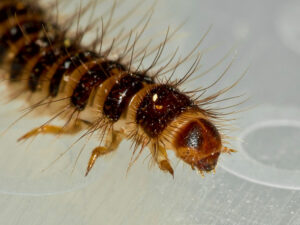 Eggs: Females lay 100–200 eggs near food. They hatch in about 1 week when warm.
Eggs: Females lay 100–200 eggs near food. They hatch in about 1 week when warm.- Larvae: 5–7 instars over about 1–2 months in warmth. Ready-to-pupate larvae leave food and may tunnel into wood, cork, foam, books, or drywall.
- Pupae: About 1–3 weeks, depending on temperature.
- Adults: Live about 2–4 months (longer when cool). They will fly to lights and windows.
Look-Alikes (and how to tell them apart)
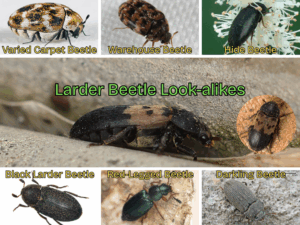 Varied carpet beetle (Anthrenus verbasci): Tiny 2–3.5 mm (2–0.35 cm; ~0.08–0.14 in), rounded, mottled scales; larvae are fuzzy “little cigars” without the two curved tail spines.
Varied carpet beetle (Anthrenus verbasci): Tiny 2–3.5 mm (2–0.35 cm; ~0.08–0.14 in), rounded, mottled scales; larvae are fuzzy “little cigars” without the two curved tail spines.- Warehouse beetle (Trogoderma variabile) / khapra relatives: 2–4 mm (2–0.4 cm; ~0.08–0.16 in), more cylindrical; larder beetles are larger with the pale band + six spots.
- Hide beetle (Dermestes maculatus) / black larder beetle (D. ater): Close cousins; adults lack the clean pale band (or are uniformly dark).
- Red-legged ham beetle (Necrobia rufipes): Metallic blue-green with red legs/antennae—slimmer and very different.
- Mealworms/darkling beetles (Tenebrio): Larvae are smooth, cylindrical “worms” without hairs; adults uniformly dark and elongated.
Giveaways for larder beetles: adult’s pale yellow band with six dots; larva’s two curved tail spines; and the habit of boring to pupate.
Where They Come From (common sources)
- Pet/fish/bird food left in original bags; treats; forgotten seed.
- Game processing/BBQ residues, jerky/charcuterie crumbs in garages/sheds.
- Dead insects in attics/fixtures.
- Rodent issues: a carcass in a wall can feed a population.
- Taxidermy, dried hides/feathers, leather, and stained wool felt.
More hints
- Round holes in wood/foam near protein sources? Likely larval pupation—patch holes and inspect nearby attractants.
- Adults on spring window sills but no pantry hits? Check attic/fixtures for dead insects and consider a mouse check.
- Garage-only issue? Secure pet/bird food and clean BBQ drips; many infestations start there.
How to Deter and Manage Larder Beetles
1) Find and remove the food source
- Audit protein-rich materials: pet/fish/bird food, jerky, dried meats/fish, dried insects, taxidermy.
- Deep clean pantry floors, baseboards, utility/furnace rooms, and garage/shed
- Discard infested items in sealed bags. Vacuum larvae and frass; empty the vacuum outdoors
2) Protect and store properly
- Use airtight hard containers (thick plastic or metal, gasketed lids). Rolled-down bags don’t count.
- Rotate stock (first-in/first-out).
- Wipe residues: BBQ areas, meat-prep spaces, compost bin rims; rinse protein containers before recycling.
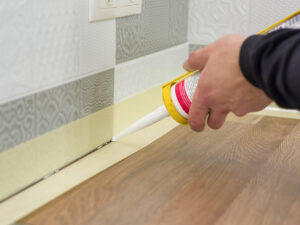 3) Break the life cycle
3) Break the life cycle
- Freezing: Place at-risk items in a deep freeze at ≤ −18 °C (0 °F) for 72 hours (a full week for dense items).
- Heat: For tolerant materials, maintain 50–55 °C (122–131 °F) for several hours to kill all stages.
- Vacuum + seal: After removing larvae, patch pupation holes and caulk cracks to stop reuse.
4) Exclusion and habitat tweaks
- Seal entry points: caulk around pipes/baseboards; repair door sweeps; screen vents.
- Reduce indoor prey buildup: better attic/soffit screening; seasonal vacuuming of dead insects.
- Rodent control: Address activity promptly; remove carcasses where accessible/safe.
5) Targeted dusts and sprays (optional)
- Crack-and-crevice dusts such as boric acid or diatomaceous earth (light applications in voids/gaps).
- Residual insecticides (home-use pyrethroids labeled for dermestids) as limited spot treatments only. Follow label directions and keep pets and kids away until dry.
- Call a pro if activity persists or a hidden food source (e.g., carcass) is suspected.
6) Monitoring
- Set sticky monitors along baseboards near suspected sources. Check weekly. Traps guide you to hotspots; they don’t solve the problem alone.
Preventive Checklist
- Store all pet, bird, and fish food in airtight containers.
- Keep BBQ/outdoor cooking areas clean; rinse protein containers before binning.
- Vacuum window sills/light fixtures seasonally to remove dead insects.
- Maintain rodent exclusion (seal gaps, set preventative monitors).
- Inspect taxidermy, hides, wool, and stored hunting/camping gear twice a year.
- After hunting/fish cleaning, deep clean the workspace and freeze any keepsakes before display (≤ −18 °C / 0 °F for 72 hours–1 week, depending on bulk).
Final Thoughts
In Edmonton, we’re used to sharing our space with nature—but not indoors with larder beetles. With a few smart steps, you can show them the door and keep your home for yourself.
Stay warm, stay tidy, and keep the beetles out of your larder!

